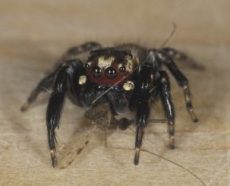A Spider’s Taste for Blood
Certain jumping spiders prey on mosquitoes that have drawn blood from animals.
By Emily Sohn
An East African jumping spider has eight legs, plenty of eyes, the hunting prowess of a cat, and a taste for blood.
An extensive series of tests has shown for the first time that these spiders don’t just eat the blood of vertebrates. They like it more than other types of food.

There are at least 5,000 species of jumping spiders. Unlike many of their relatives, these spiders don’t build webs. Instead, they hunt the way cats do. They stalk midges, ants, spiders, and other prey, creeping to within centimeters of a victim. Then, in a tiny fraction of a second (0.04 second), they pounce.
One East African species of jumping spider (called Evarcha culicivora) doesn’t have the mouthparts to get through vertebrate skin to suck blood. Instead, it preys on female mosquitoes that have recently taken blood from animals. The spider eats the blood-filled insects.
Robert Jackson of the University of Canterbury in Christchurch, New Zealand, was one of the scientists who discovered and named E. culicivora 2 years ago. He noticed lots of these spiders living in and near houses in Kenya. To find out why, he launched a series of experiments.
First, Jackson and his coworkers presented the spiders with different types of prey. The spiders were quick to attack mosquitoes. This showed that the eight-legged creatures find mosquitoes to be yummy.
To find out whether E. culicivora prefer mosquitoes to other food, the researchers put spiders in clear boxes. From each of the four sides of the box, the animals could enter tunnels that led to dead-ends. The scientists placed prey outside each tunnel. They put one type of prey at two of the tunnels and a different type at the other two. The prey were dead, but they were mounted in lifelike poses.
Experiments with 1,432 spiders showed that more than 80 percent of the spiders chose tunnels leading to mosquitoes that had eaten blood. The rest chose to approach other species of prey.
In other tests, about 75 percent of spiders chose to approach female mosquitoes that had eaten blood rather than males (which don’t eat blood). They also chose female blood-eaters over the same kind of mosquitoes forced to feed on sugar instead.
Finally, the scientists pumped the odors of various prey into the arms of a Y-shaped test chamber. They found that spiders moved toward arms holding the scent of female blood-fed mosquitoes over other scents.
Even spiders that were raised in the lab and had never tasted blood were drawn to the sight and smell of blood-fed mosquitoes. This suggests that the taste for blood is something that this kind of jumping spider is born with.
The studies also mean that when a mosquito in East Africa bites you, your blood might eventually end up in the belly of a hungry jumping spider.
Going Deeper
Milius, Susan. 2005. Proxy vampire: Spider eats blood by catching mosquitoes. Science News 168(Oct. 15):246. Available at http://www.sciencenews.org/articles/20051015/fob8.asp .
You can learn more about Robert Jackson’s research on spiders at www.biol.canterbury.ac.nz/people/jacksonr/jacksonr_res.shtml (University of Canterbury).







